Review: Dacia Night Train Vienna to Bucharest
This review details a trip on the “Dacia” night train between Vienna (Austria) and Bucharest (Romania).
A ride on the Dacia night train
After a fun trip on the “Croatia” EuroCity train from Zagreb to Vienna, it was time to take the last leg on my Interrail adventure across Europe.
I would travel on the night train from the Austrian capital of Vienna back to my home city, the Romanian capital of Bucharest.
This sleeper train is named the “Dacia” and is operated by CFR Călători, the passenger transport division of the Romanian Railways.
It’s a long but beautiful journey which will take you across the Hungarian plains, the rolling hills and forests of Transylvania and finally the Carpathian Mountains.
In railway timetables the Dacia is shown under the train number of D347 or IRN347 when running from Vienna to Bucharest and as D346 or IRN346 when running in the opposite direction from Bucharest to Vienna.
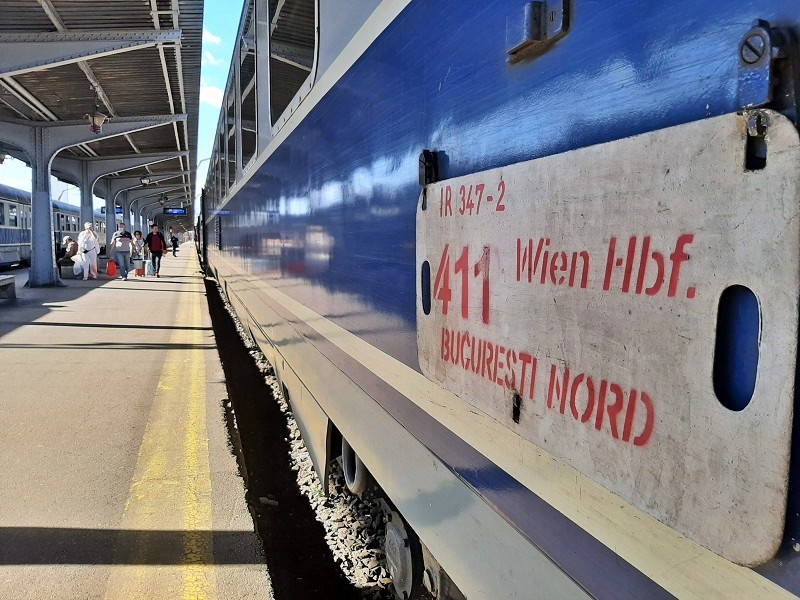
Booking the Dacia train
It’s straightforward to book a journey on the Dacia night train at the Austrian Railways website, the Romanian Railways website, or at a ticket office or machine at the station.
When booking your ticket online, you will be issued a PDF e-ticket that you can show to the train conductor.
You can book a ticket on the Dacia night train in the following travel classes:
– 2nd class seat
– couchette (both 6 and 4-berth couchettes are available)
– sleeper (3, 2 and 1-berth sleepers are available)
If you are travelling alone and book just a single berth in a couchette or 3 or 2-berth sleeper, you will share the compartment with other travellers of the same sex.
Dacia train prices
In order to get the best prices and to have the assurance of a seat or berth on your preferred travel date, it’s advisable to book as far in advance as you can.
One-way prices start at €49 for travel in a 2nd class seat, €59 in a 6-berth couchette, €69 in a 4-berth couchette, €99 in a 2-berth sleeper and €159 in a single sleeper.
If you travel with an Interrail or Eurail pass, you only require a seat reservation, couchette or sleeper supplement to travel on the Dacia night train.
When using a rail pass, a 2nd class seat reservation will cost you €3, while a supplement for a 6-berth couchette is €13.40, a 4-berth couchette €20 and a 2-berth sleeper €42.
The Interrail or Eurail supplement for a single sleeper is €98 and can only be booked by first class pass holders.
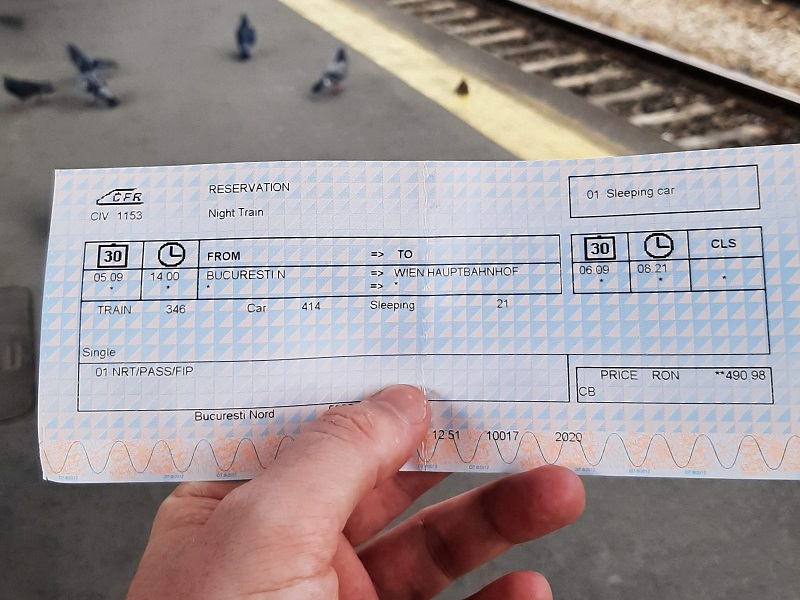
Wien Hbf
A trip on the Dacia starts (or ends) at Vienna’s main railway station, which is called Wien Hauptbahnhof (Hbf) in German.
It’s a modern station with all the facilities you might need such as a supermarket, fast food restaurants and left luggage lockers.
The platforms are one level above the main train station hall and underpass.
At the platform, you can find a digital screen showing the train formation and the exact place along the platform where your carriage will halt.
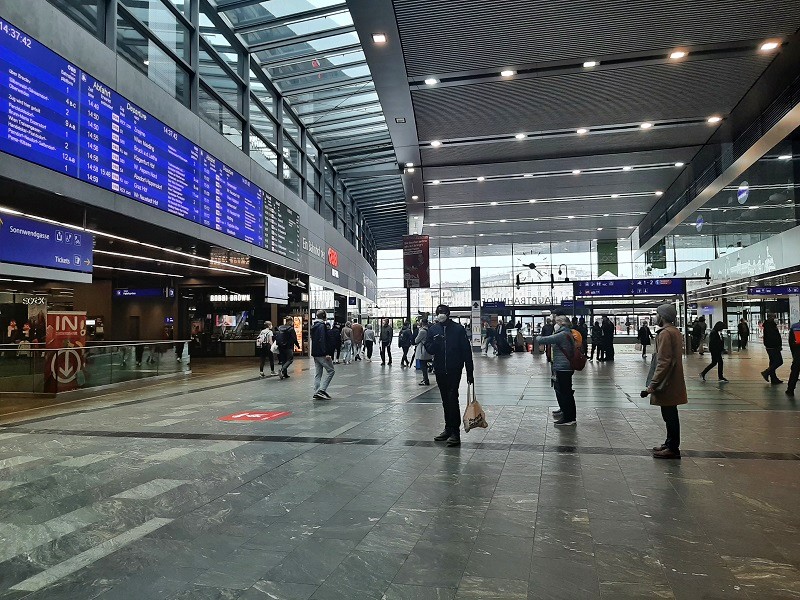

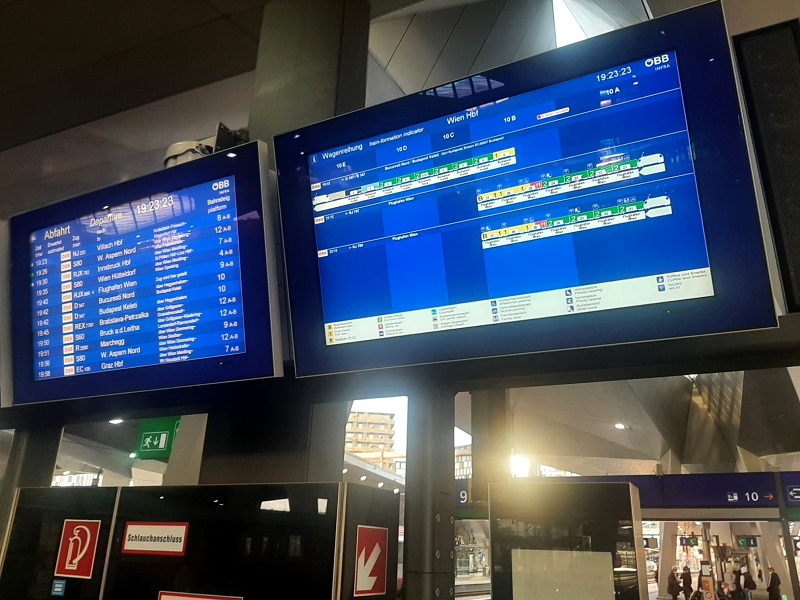

The train arrives
Some 15 minutes before its scheduled departure, the Dacia night train pulled into Vienna’s main railway station.
I was booked in a single sleeper for the ride to Bucharest, which happened to be the front wagon of the train right behind the locomotive.
Apart from the CFR carriages, the train also carries some Hungarian Railways seating carriages (MÁV) which are decoupled from the Dacia in Budapest and are only meant for passengers travelling between Austria and Hungary.
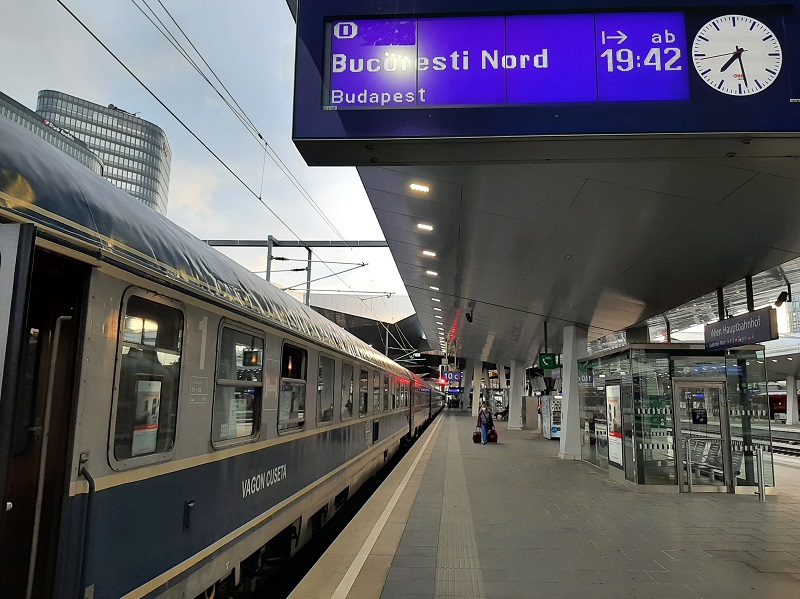



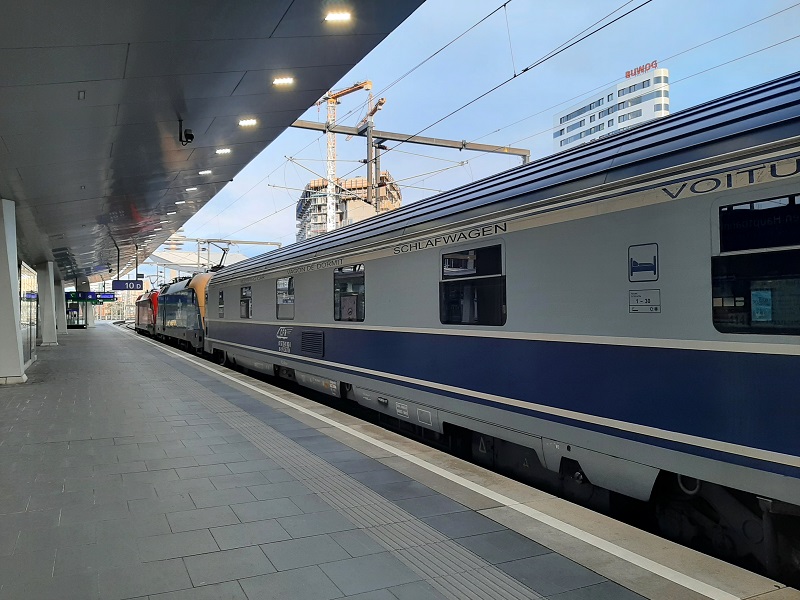

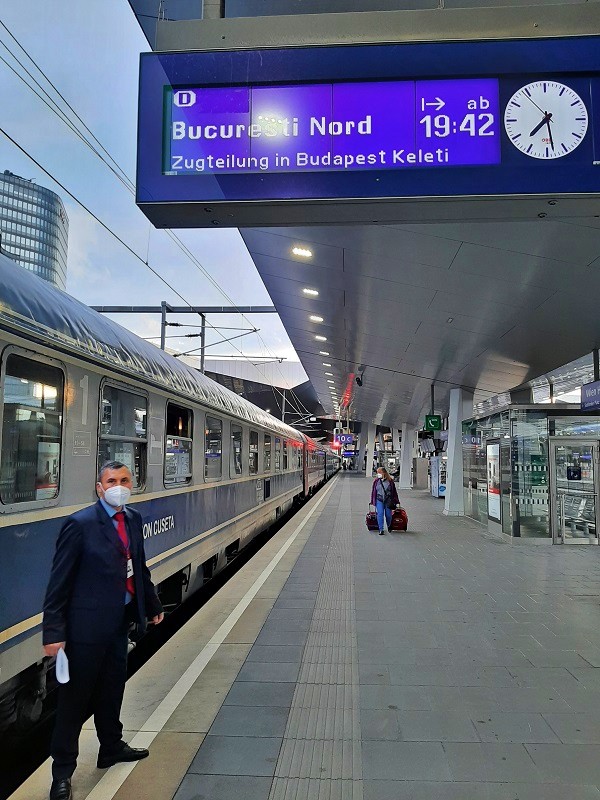
Sleeper compartment
I was booked in berth number 11 in a standard sleeper compartment for sole occupancy.
My sleeper compartment on the Dacia train wasn’t the most modern, although it was certainly spacious, clean and comfortable.
The bed was already made when I entered the compartment, although if you want you can fold away the bed if you want to use the normal seats.
The compartment has a small side table, washbasin and coat hangers for your jacket or clothes.
There is a climate control button by which you can adjust the temperature of the air-conditioning/heating inside the compartment.
Although there is no WiFi internet on the Dacia train, there is at least one power socket in each sleeper compartment (depending on the exact type of sleeper wagon it can be at the table, on the wall next to the door, or inside the washstand).
A basic amenity kit (with a toothbrush, toothpaste and some wipes) as well as one bottle of water is provided as well to passengers travelling in a sleeper compartment.
As all sleeper and couchette compartment doors can be locked from the inside, travelling on the Dacia night train is perfectly safe.
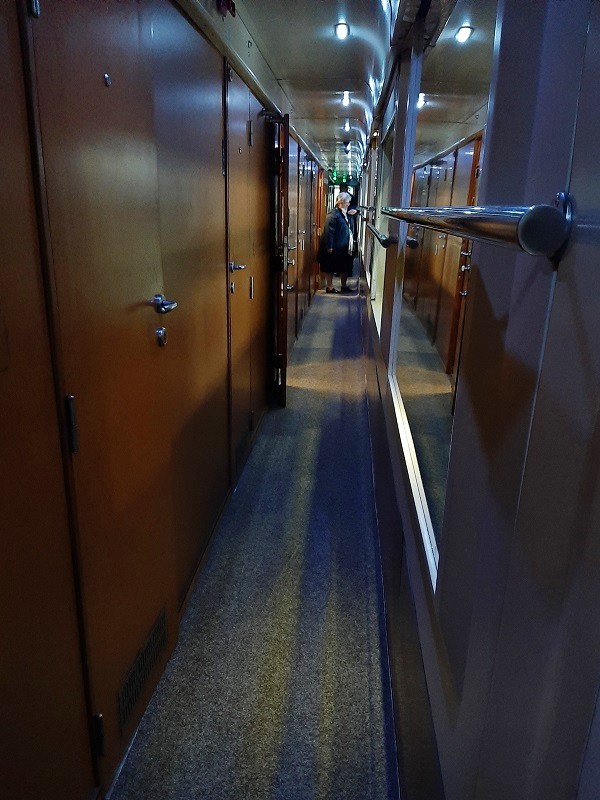
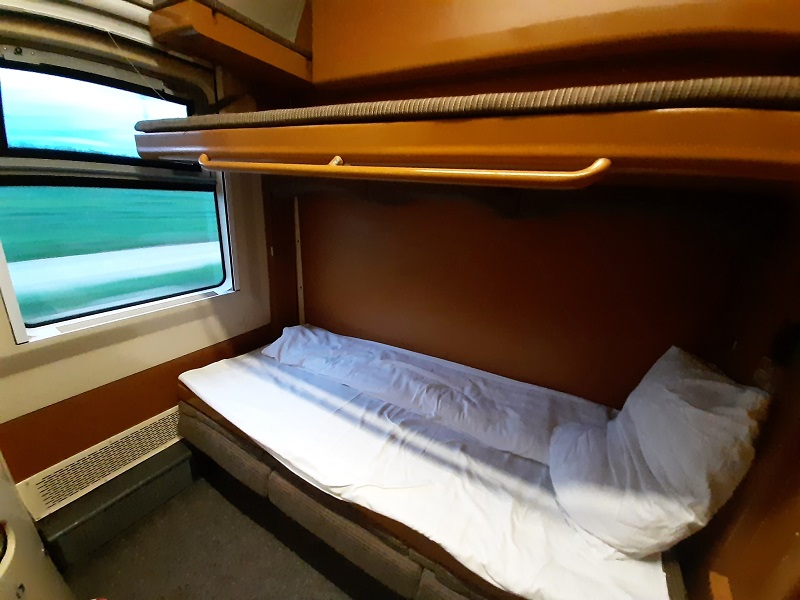

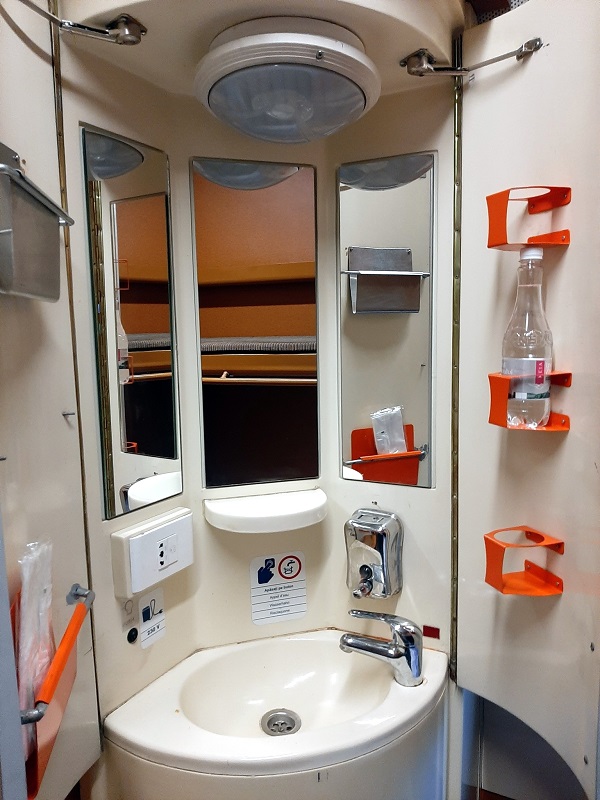
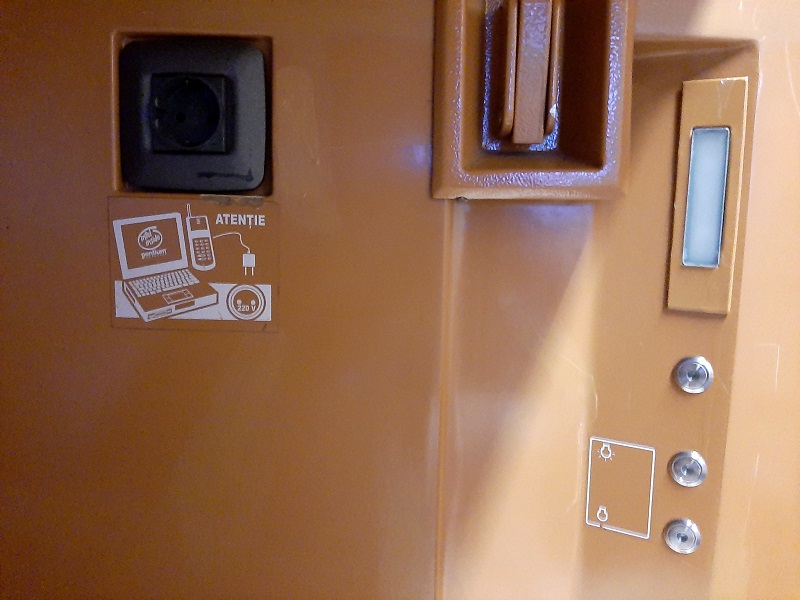
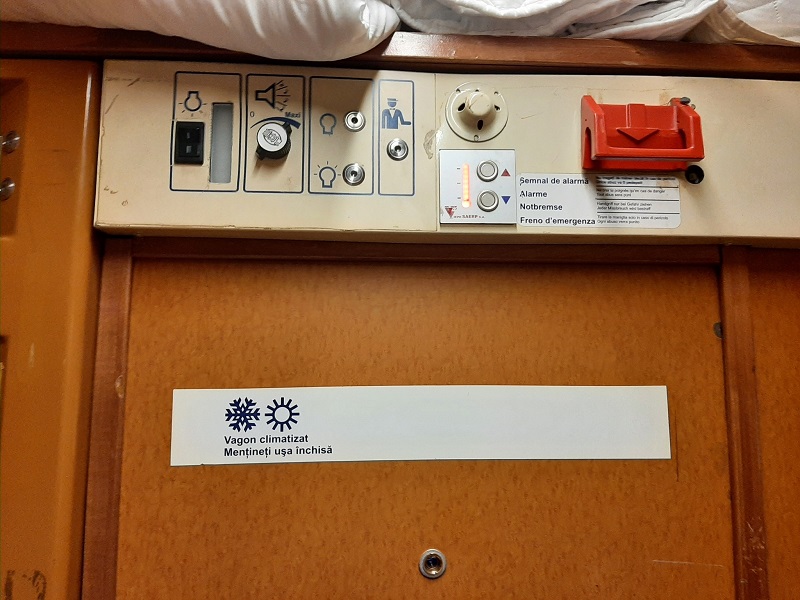
En-suite sleeper
Although I was booked in a standard sleeper compartment, the Dacia night train also has four en-suite sleeper compartments.
If you book your ticket online you cannot specify which compartment you want, so it’s all down to luck whether you get assigned a standard sleeper compartment or an en-suite compartment.
Berths 21/25, 31/35, 41/45 and 51/55 are the ones located in en-suite sleeper compartments – and if you book your ticket at the station it cannot do harm to ask whether one of these are still available.
Do note that berths 21/25 are the lower and upper berth in the same compartment, so don’t be surprised if you are travelling as a couple and the allocated berths aren’t sequential.
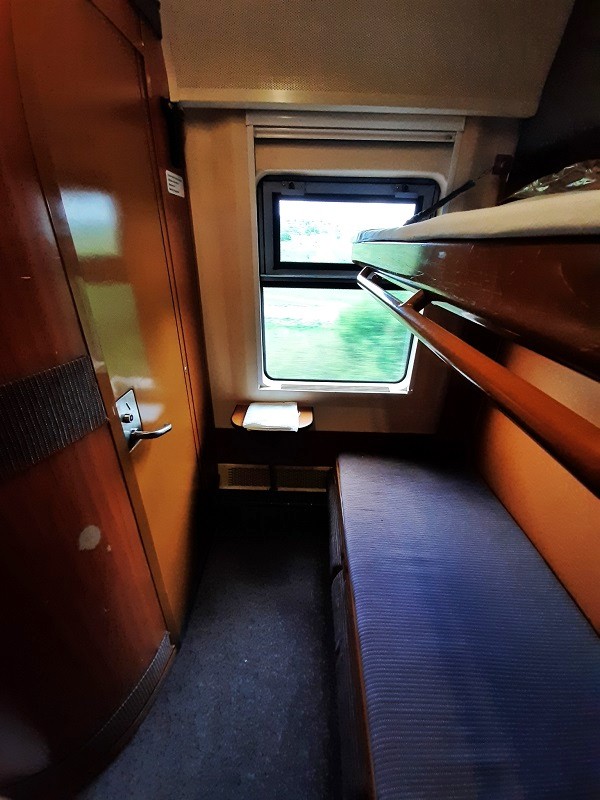


Other travel classes
Below you can also find pictures of a 4-berth couchette compartment and 2nd class seating on the Dacia night train.
Although the couchettes are a bit basic, they are ideal for budget travellers as well as families or groups of friends travelling together.
Bedding is provided as well in couchettes, although you do have to make your own bed.
I personally wouldn’t recommend travelling in a 2nd class seat on the Dacia – especially given the fact that a couchette doesn’t cost much extra.
It’s a long ride between Vienna and Bucharest and as the 2nd class seats are usually in 6-seat compartments instead of saloon cars, they aren’t comfortable nor very private when the train is fully booked.


Toilet and shower
If you don’t have an en-suite sleeper compartment, you can find a shared toilet at both ends of each carriage.
The sleeper carriage also has one shower compartment which can be used by passengers travelling in a standard sleeper compartment.
Towels aren’t proactively provided, so do ask the carriage attendant for one (it’s called a ‘prosop’ in Romanian in case the conductor doesn’t speak much English or German).


Sleeper Train “Dacia” Vienna to Bucharest
Train D347 – Departure: 7.42pm – Arrival: 4.04pm (+1 day)
Duration: 19h22m – Distance: 1,127 kilometres
Standard sleeper, Wagon 414, Seat 11 – Costs: 98 EUR

Vienna departure
The Dacia sleeper train departed Vienna’s main railway station on time.
Austrian train travel legend and Twitter friend Helmut was kind enough to shoot a video of the departure of my train from one of the adjacent platforms!
Of course, I also made a short video myself how the departure looked like from the comfort of my own sleeper compartment.
Abfahrt D 347 "Dacia" (Wien 🇦🇹- București 🇷🇴) heute abend. pic.twitter.com/ElP765Swsh
— Helmut Uttenthaler 🇺🇦 📯 (@vorortanleiter) May 13, 2021
On the way to Hungary
The first couple of hours of the train ride between Vienna and Bucharest aren’t the most exciting.
The scenery in both Austria and Hungary is rather flat and you’ll be mainly looking at agricultural fields from the window.
I therefore just relaxed on my bed listening to some music and enjoying a beer and some sausages.
Between Vienna and the Austro-Hungarian border, the Dacia doesn’t make any stops, although it does call at the Hungarian border station of Hegyeshalom.
As both Hungary and Austria are part of the Schengen Zone, there are no passport or customs checks at this border.
In Hungary, the train also halts in the city of Győr and in Tatabánya.
Only between Tatabánya and Budapest does the landscape get a bit more hilly, although at this point it will likely be dark outside already.
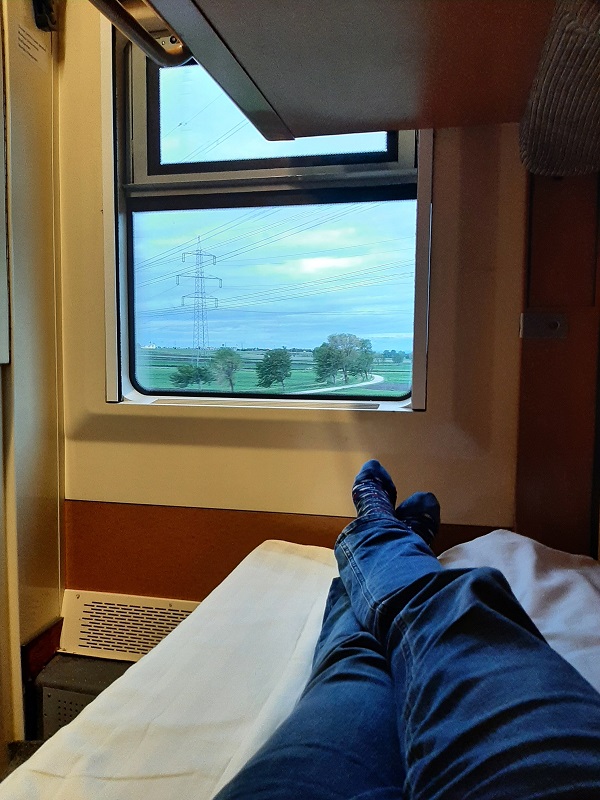
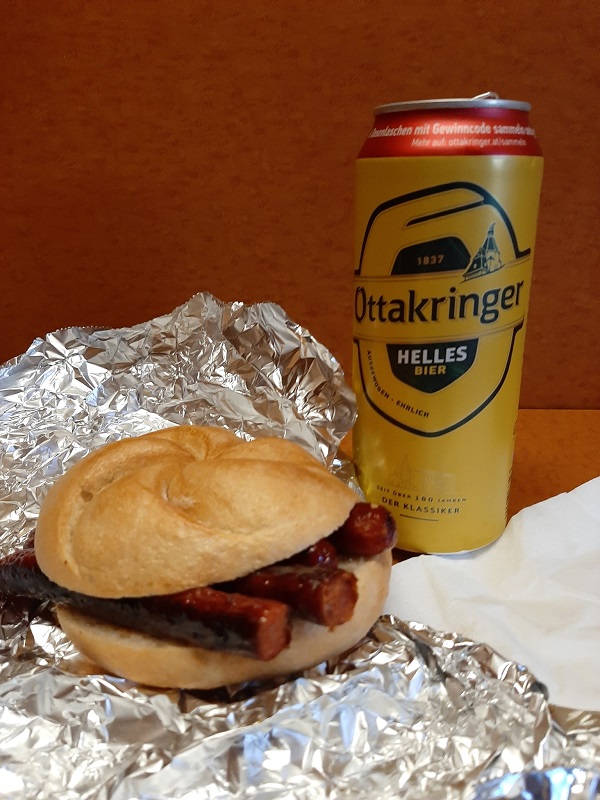

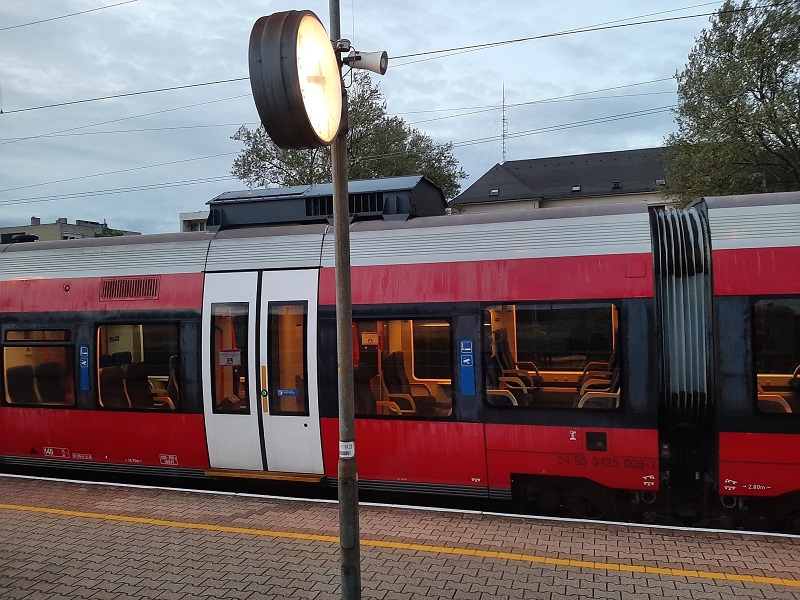

Budapest stop
In Budapest, the Dacia train first calls at the secondary Kelenföld station before pulling into the magnificent terminus station of Budapest-Keleti.
Budapest Keleti Pályaudvar, which is Hungarian for “Eastern railway station”, is one of the world’s most magnificent train stations.
As it’s a terminus station, the Dacia train will need to reverse direction.
The MÁV Hungarian Railways seating carriages are decoupled from the Dacia and a new locomotive is attached at the other end of the train.
As this process takes a while, the planned stop at Budapest Keleti station can take anywhere between 25 and 50 minutes depending on the exact train schedule (it took 50 minutes when I travelled).
It’s the perfect opportunity to stretch your legs on the platform and to admire the beautiful surroundings of the railway cathedral that is Budapest Keleti station.
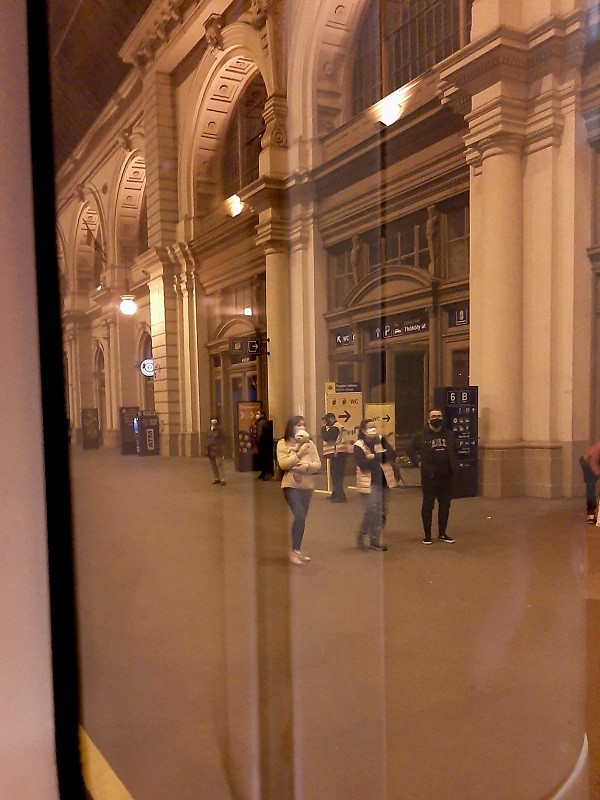

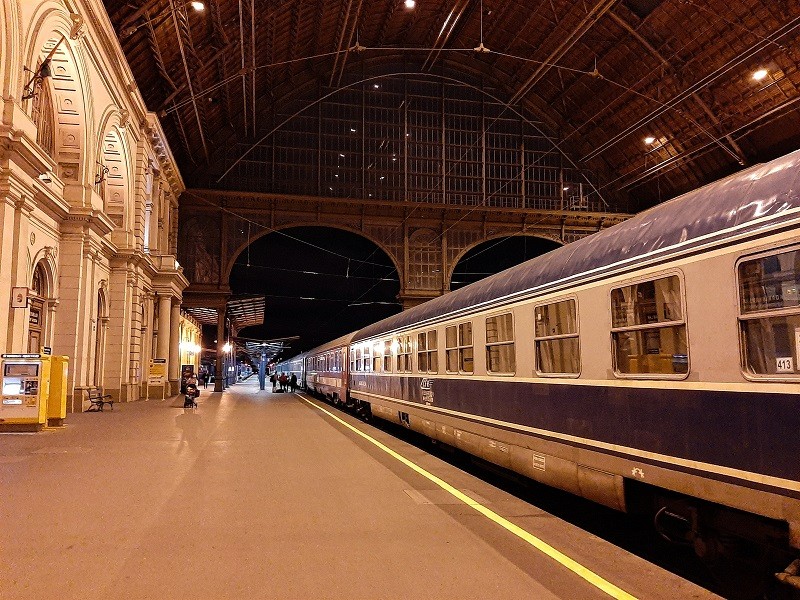
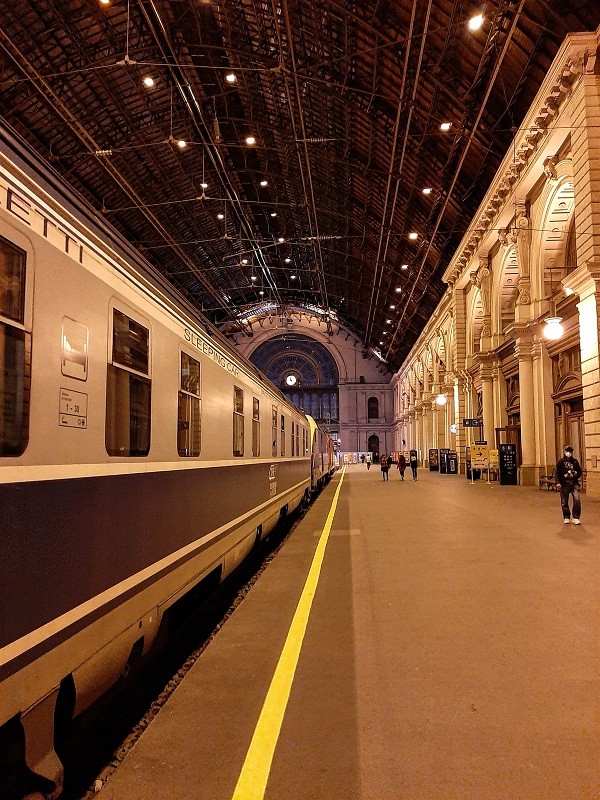
Hungarian-Romanian border
After departure from Budapest, the Dacia train stops at the Hungarian stations of Szolnok and Békéscsaba.
Around 2am local time, the train arrives at the Hungarian border station of Lőkösháza.
Hungarian border guards board the train at this station to check passports – you simply remain in your compartment or seat when this is done.
If you are not awake at this point (I always put set my alarm clock 5 minutes before arrival at this border station) they will simply knock on your compartment door as long as it takes to wake you up!
After the stop at Lőkösháza, the train continues for the short ride to the Romanian border station of Curtici.
Here, the entire process repeats itself, although this time it’s the Romanian border guards who perform passport and customs checks on board the train.
Do note that Romanian time is one hour ahead of Hungarian time so you need to put your clocks forward!

Morning in Transylvania
Although the border checks in the middle of the night are somewhat inconvenient, you have a lot of time in the morning to sleep in.
I woke up well-rested just after 9am when the Dacia train was riding somewhere between Mediaș and Sighișoara.
We are now in the heart of Transylvania and the scenery of rolling hills and quaint villages is already something entirely different than the view from the window at the moment you went to bed in Austria or Hungary.
At this part of the journey, the train rides on a recently modernised railway track at relatively high speeds – which is rare for Romania.
If you are awake at this point, you can try to spot the Saxon fortified church of Șaroș pe Târnave on your right-hand side.
This part of Transylvania is famous for its Saxon fortified churches and besides the one at Șaroș pe Târnave there are a few others you can see from the Dacia sleeper train at a later stage.


Dacia dining car
The Dacia night train usually features a dining car, which is attached to the train in the early morning at the station of Simeria.
This means that you can have a cooked breakfast or lunch in the dining car when travelling from Vienna to Bucharest.
When travelling the other way around from Bucharest to Vienna, you can use the dining car for a late lunch, dinner or drinks before it is decoupled from the train before the Dacia reaches the Hungarian border.
Unfortunately, when I travelled on the Dacia during this journey the restaurant wagon wasn’t attached to the train due to COVID regulations which were in force back then.
However, when the dining car is attached it makes for an excellent spot to enjoy a meal or a drink or two and an experience in its own right.
That said, I would always suggest to bring enough food and drinks with you as a precaution in case the dining car isn’t attached, as you don’t want to be stuck on such a long train ride without anything to eat or drink.
The menu of the Dacia’s dining car is rather limited compared to restaurant wagons on other European trains as it basically only lists dishes such as an omelette, sandwiches and grilled meats.
However, if you are a carnivore you will love the freshly grilled meats.
For a mixed grill, a side salad, some water and a bottle of wine you won’t pay more than 15 euro.
Do make sure you bring Romanian lei or euros cash as cards are not accepted in the dining car of the Dacia!
Update 2023: The dining car has been indefinitely withdrawn from the Dacia since the timetable change of December 2022 and it’s not sure if and when it will return. Instead, a bar wagon selling drinks and basic snacks is attached to the train, although weirdly enough it’s not always open so I do highly recommend to bring your own food and drink supplies. I’ll report back when anything changes again!

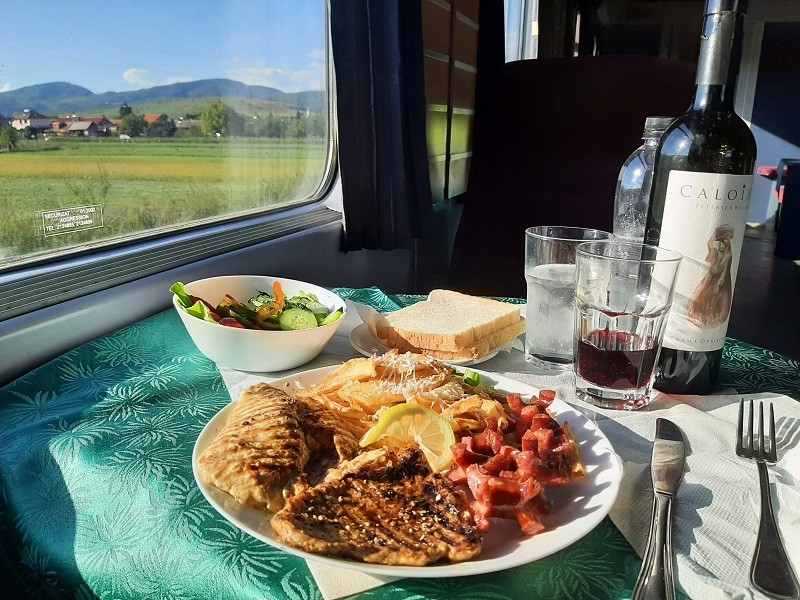

Sighisoara stop
One of the most important stations between Vienna and Bucharest is the city of Sighișoara, where the Dacia night train will make a short stop.
Sighișoara is one of Romania’s most beautiful cities and you should definitely include this destination on your itinerary when visiting the country.
Sighisoara was founded in the 12th century by Saxon settlers who gave it the German name of Schässburg.
The city is one of the seven fortified cities after which the Siebenbürgen (the German name for Transylvania which literally means ‘Seven Castles’) is named.
Sighisoara is well-known for it’s picturesque medieval old town and for being the birthplace of Vlad Țepeș (Vlad the Impaler), the infamous historical figure on whom Bram Stoker based his character of Dracula.
You have a fantastic view of the hilltop citadel on the right-hand side of the train shortly before the Dacia arrives at the station of Sighișoara.

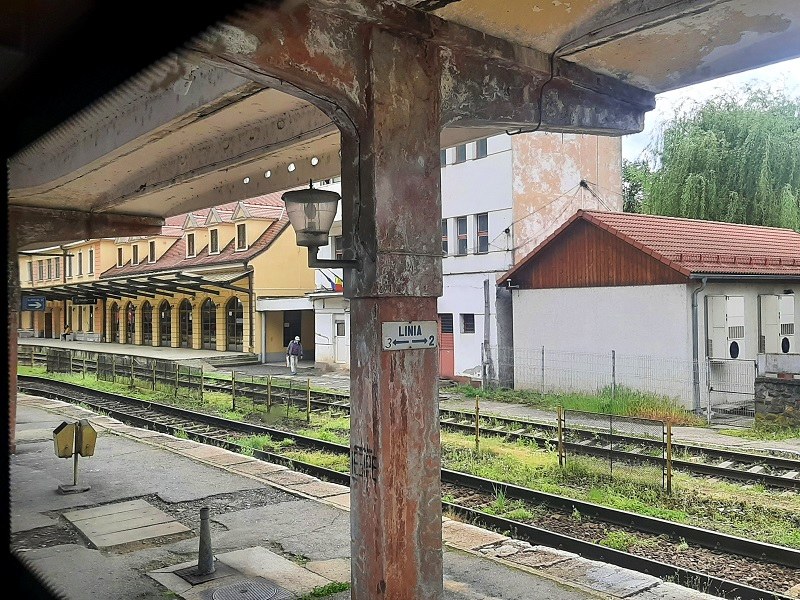
Coffee and shower
After departure from Sighisoara you get the opportunity to see two other Saxon fortified churches from the train, first the one in the village of Archita on your right-hand side and a bit later the fortified church of Cața on your left-hand side.
At this point, I started to chat a bit with the sleeping wagon attendant, who kindly offered a coffee and the opportunity to take a shower.
Outside, the weather was getting increasingly gloomy as it looked like a springtime rain storm was soon to hit Transylvania.
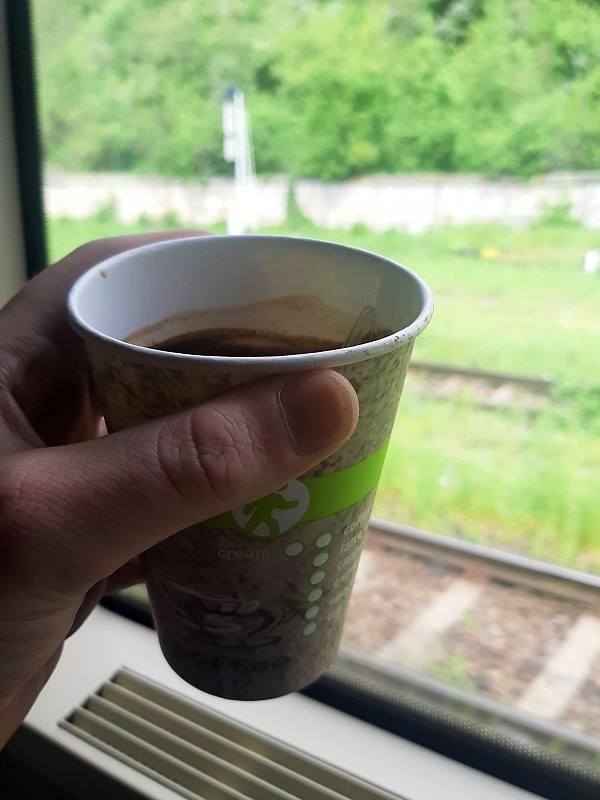


Delay
At this point, we were already running with a delay of about an hour.
Train delays are very common in Romania – especially so for international sleeper trains like the Dacia – and you should therefore never plan short onward connections into your itinerary.
When taking a train to or from Romania, it’s smart to calculate at least an hour or two extra on top of the normal journey time just to be on the safe side.
Racos
The Dacia night train runs non-stop between Sighişoara and Braşov and on this stretch you can clearly see why this train is so slow.
While you can easily drive between Sighişoara and Braşov in under two hours, it takes the Dacia train three hours to complete this part of the journey.
About halfway between Sighişoara and Braşov the train passes through the station of Racoș, a majority-Hungarian town famous for an extinct volcano and abandoned castle.
River valley
The reason why the Dacia sleeper train is so slow – or any other train travelling on this stretch for that matter – has to do to the railway tracks.
As the railway infrastructure in Romania is rather rickety due to years of poor maintenance and underinvestment, the maximum speed on many lines is astonishingly low.
The average speed on this part of the line isn’t faster than 50 kilometres per hour.
However, it’s not only the track quality that contributes to the slow ride.
The railway line between Sighişoara and Braşov is built along a meandering river in a forested valley and due to the many curves and inclines a high top speed is simply not possible.
On the plus side, it does however make for a beautiful ride as parts of this railway line are far away from civilisation with hardly any houses to be seen, let alone any sign of a road.
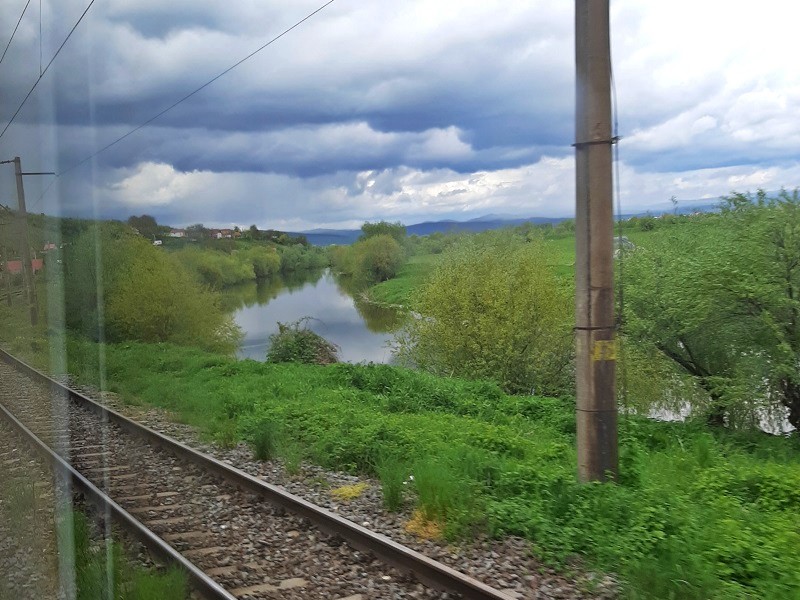
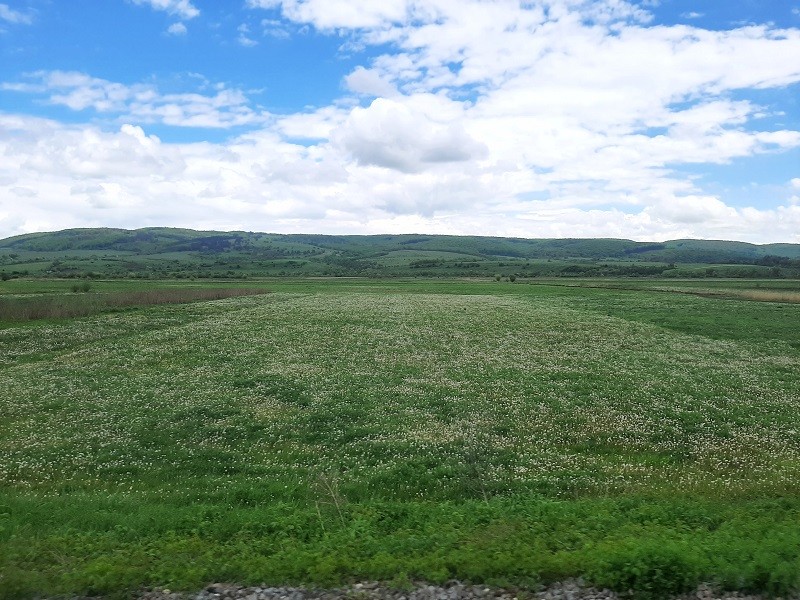

Approaching Brasov
Transylvania has always been a multicultural region.
When you ride on the Dacia night train between Vienna and Bucharest, you will pass by towns which might have ethnic Romanians, Hungarians, Germans and Roma living in them.
Although the great majority of the people in all of Transylvania are Romanian, there are some towns and villages where ethnic Hungarians or Roma form a plurality or even the outright majority.
This is for example the case in the village of Ormeniș, where a plurality of the people are Roma and Hungarians and Romanians are respectively the second and third largest groups.
Although lots of towns in Transylvania were founded by ethnic Germans known as the Transylvanian Saxons, there aren’t that many remaining and it’s rare for them to top the 1 or 2 percent mark when looking at the demographics.
Many ethnic Germans were killed in World War II or fled alongside the retreating Nazi forces when the Soviet Army swept through Romania, while perhaps even more left the country for Germany after the fall of communism when they were finally able to get a passport and migrate abroad.



Rain
Just as the train passed non-stop through the station of Apața, it finally began to rain.
Although the track quality of this part of the railway line is rather poor to begin with, the rain and stormy conditions made for even slower speeds than before.
However, despite the rain and dark clouds the view was still quite pretty.
At Rotbav, the train passes a series of small lakes.
Moments later, you can see the fortress and Saxon fortified church of Feldioara on your right-hand side, although this time around I didn’t see much of it due to the pouring rain.

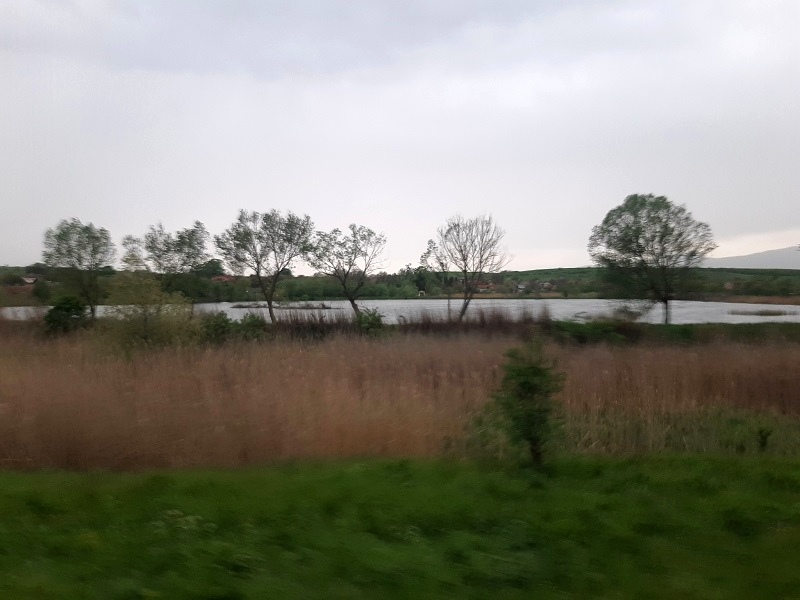


Brasov
Some three hours after departure from Sighișoara, we finally approached Brașov.
After Bucharest, the city of Brașov is the second most important stop in Romania where the Dacia night train calls.
Although it might not look very idyllic when you look at the city’s communist-era train station and surrounding blocks of flats, Brașov is actually a beautiful place and one Romania’s top tourist draws.
Brașov has a picturesque medieval old town wedged between some mountains and just like Sighișoara this beautiful city should definitely be included on your Romanian itinerary as well.



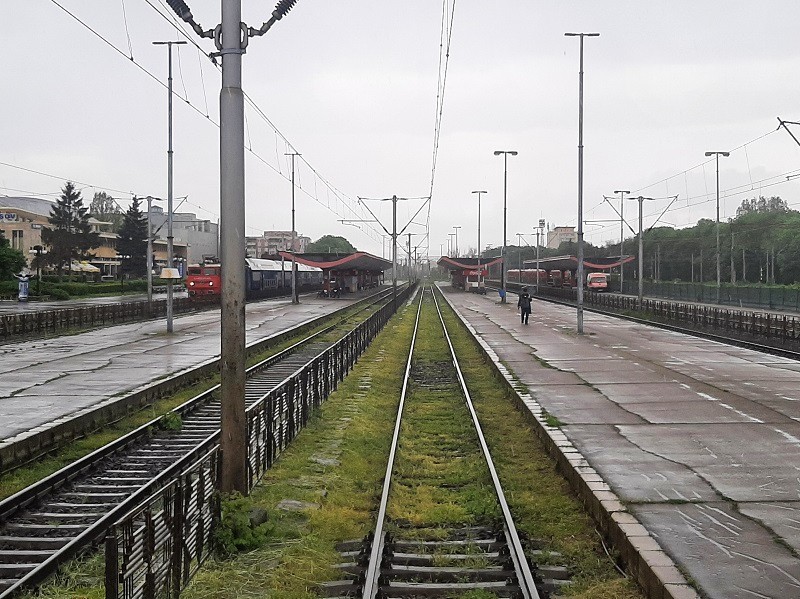
Crossing the Carpathians
The highlight of the Dacia night train is arguably the moment when it crosses the Carpathian Mountains.
That means that when you are travelling all the way from Vienna to Bucharest, the best is left for the final stretch of this epic night train journey.
When crossing the Carpathians from north to south, the best views are on the left-hand side of the train when you climb up from Brașov to Predeal and on your right-hand side when you descend down again from Predeal towards Ploiești.
The ride up from Brașov to Predeal is characterised by dark pine tree forests and tunnels, although there is the occasional pretty view
The highest train station in Romania is the mountain resort Predeal, it being located at an altitude of just over 1,000 metres above sea level.
Predeal is also roughly the location of the Carpathian watershed and the unofficial border between the Romanian regions of Transylvania and Wallachia.

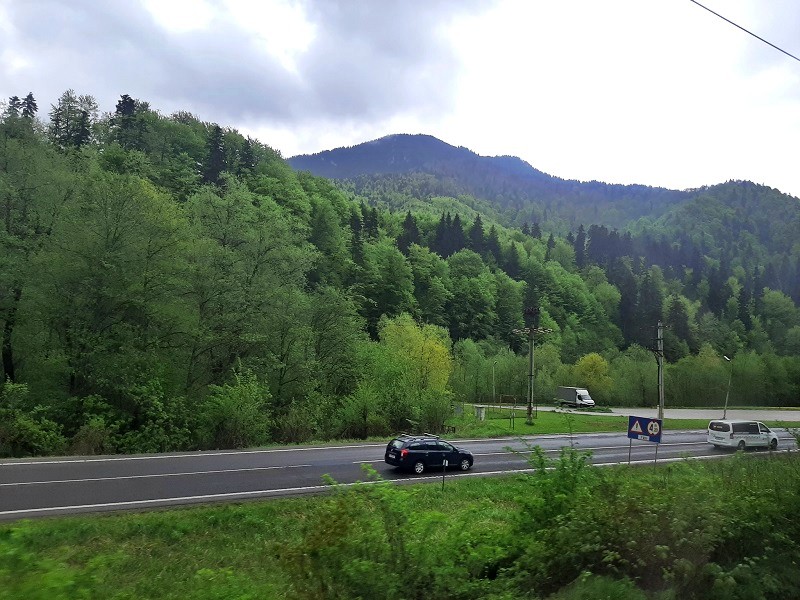


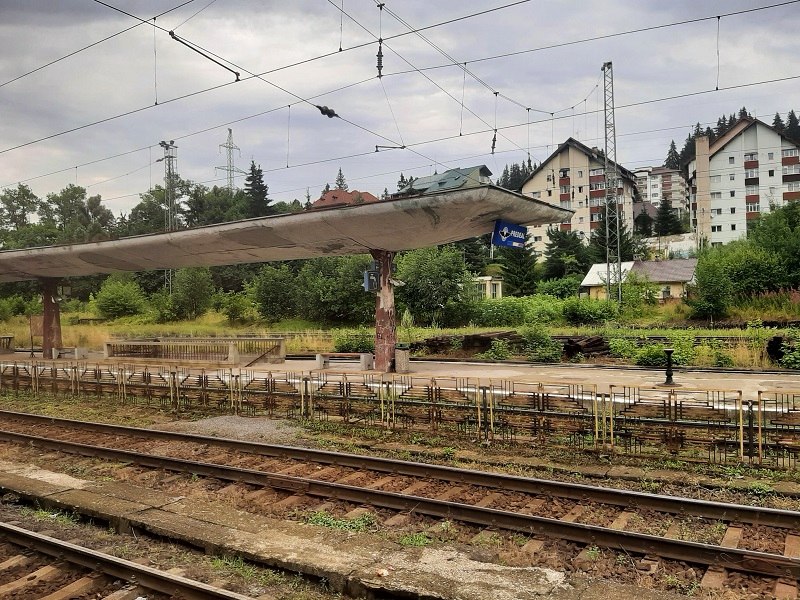
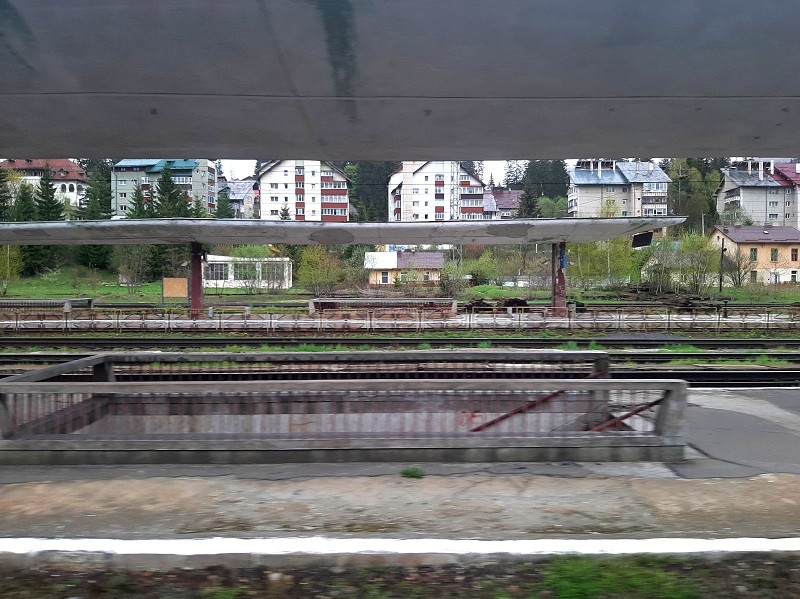
Predeal to Sinaia
After Predeal, the views from the Dacia night train really start to get pretty as the highest mountain peaks of this part of the Carpathians suddenly appear in the distance.
We are now in the upper part of the Prahova Valley, which is home to some of Romania’s most famous mountain and ski resorts.
The best views of the entire journey can be seen shortly before and after the Dacia night train passes through the mountain resort of Bușteni.
When the weather is good and the skies are clear, you can easily spot the 2,384-metre (7,822 ft) high Caraiman Peak with its large summit cross on top.
Due to the rainy weather the Carpathian views were hardly the best I’ve ever seen them travelling on this railway line, although the silhouettes of the mountain peaks were still impressive.
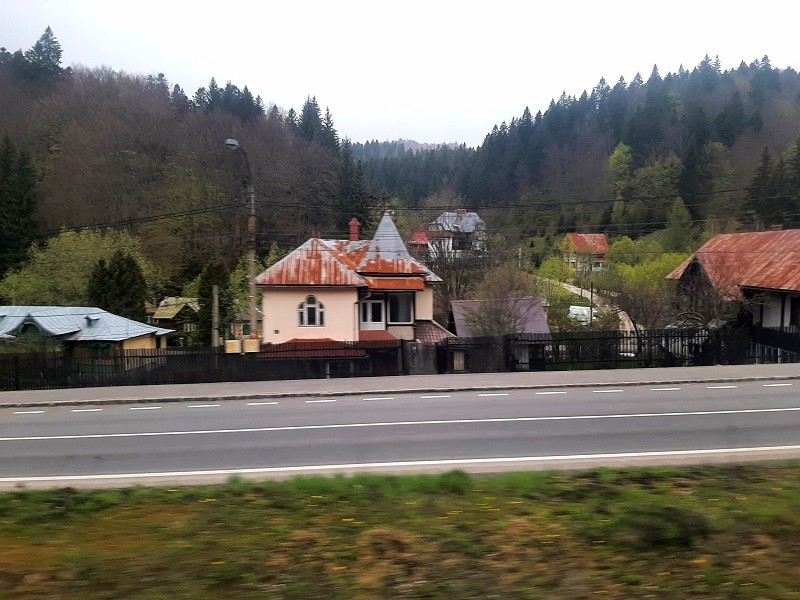
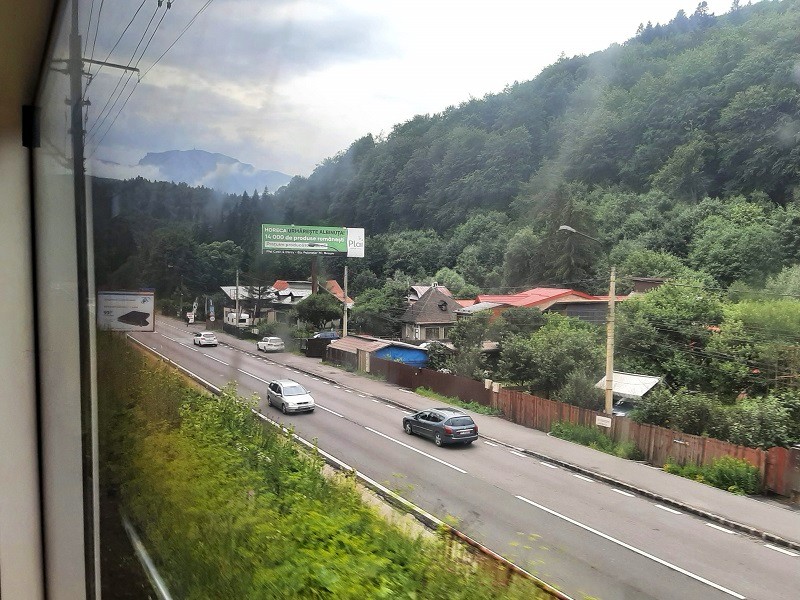


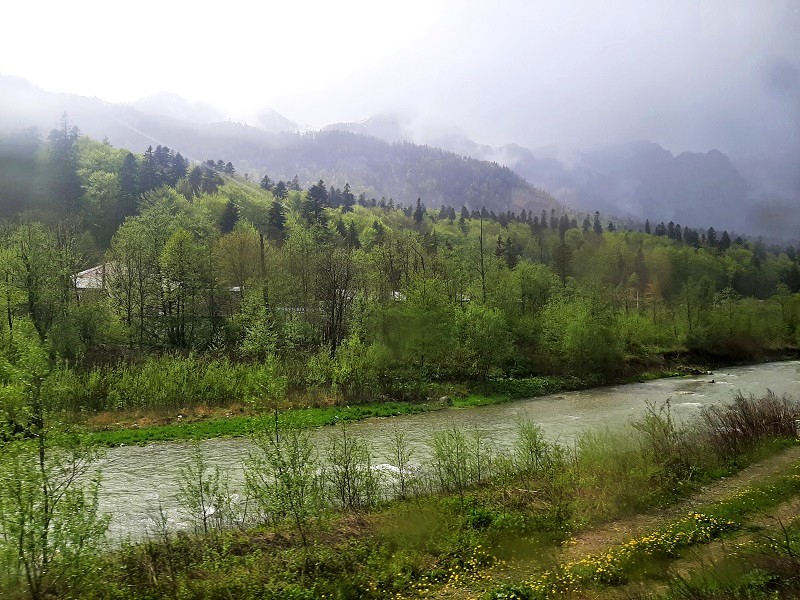
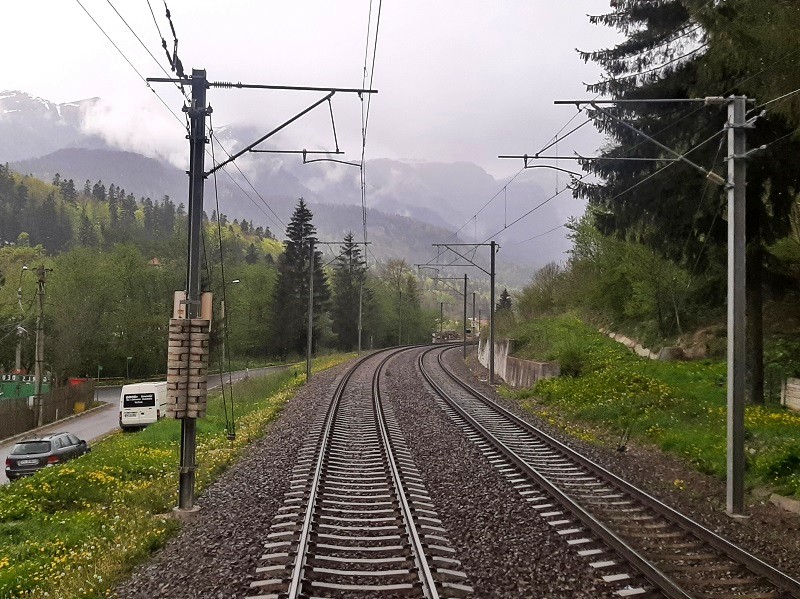
Sinaia
Sinaia is another important stop for the Dacia night train as it’s arguably Romania’s most famous mountain resort town.
Just outside the town of Sinaia you can find beautiful Peleș Castle, which was built as a summer retreat by the Romanian Royal family.
Because of the royal pedigree, Sinaia has a rather grand railway station which is easily the prettiest of all the Romanian station stops of the Dacia train.
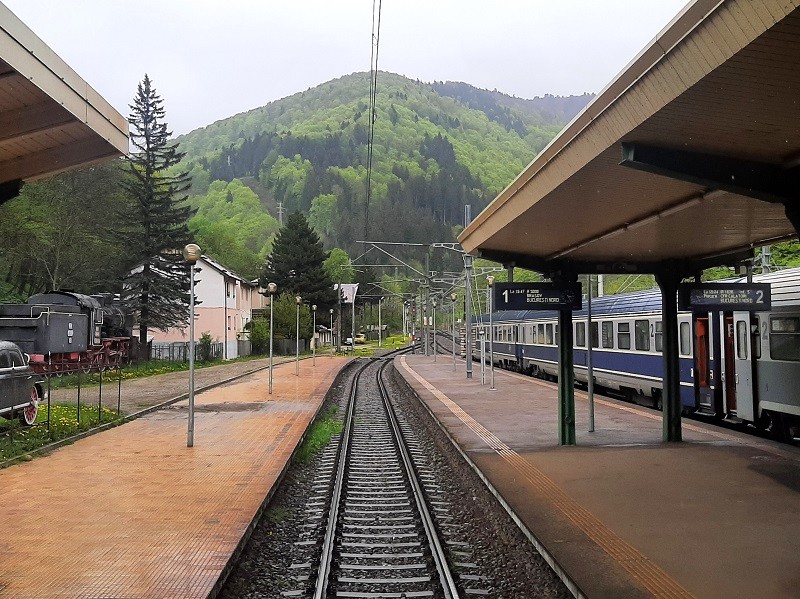
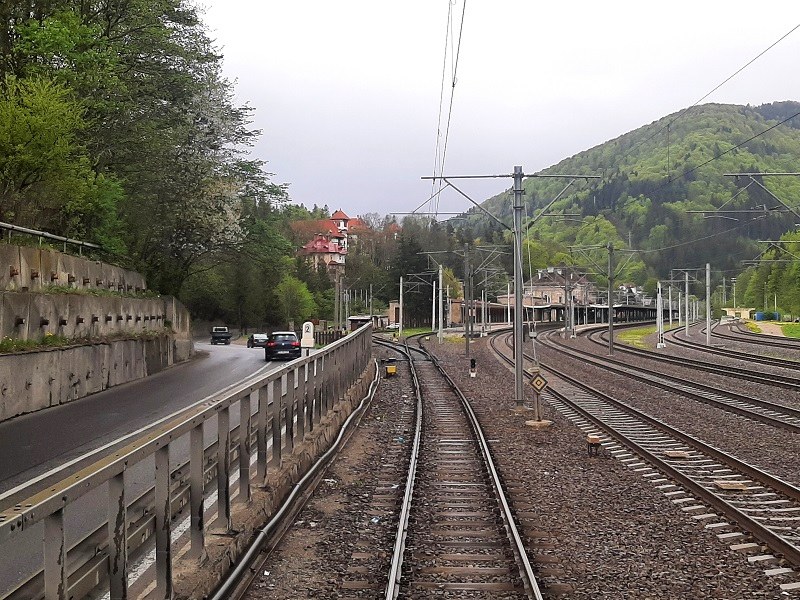
Onto the Wallachian plains
Once the train has left Sinaia, the best of the scenery is definitely behind you.
The train now follows the Prahova River through the southern Carpathian foothills, which slowly give way to the Wallachian plain.
The Dacia train makes one last stop at the station of Ploiești Vest before continuing on its final stretch to Bucharest.
Ploiești is famous for its oilfields and from the train window you can easily spot a couple of refineries and lots of freight trains with tank wagons.

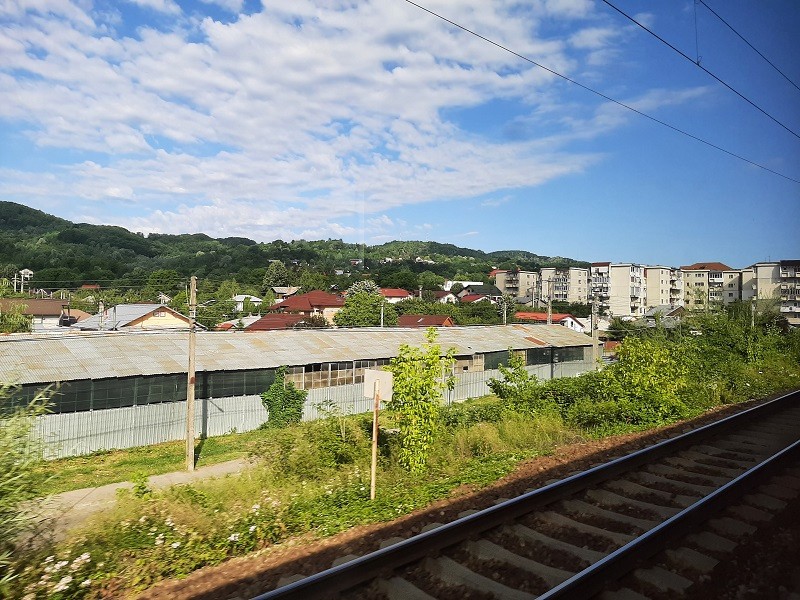

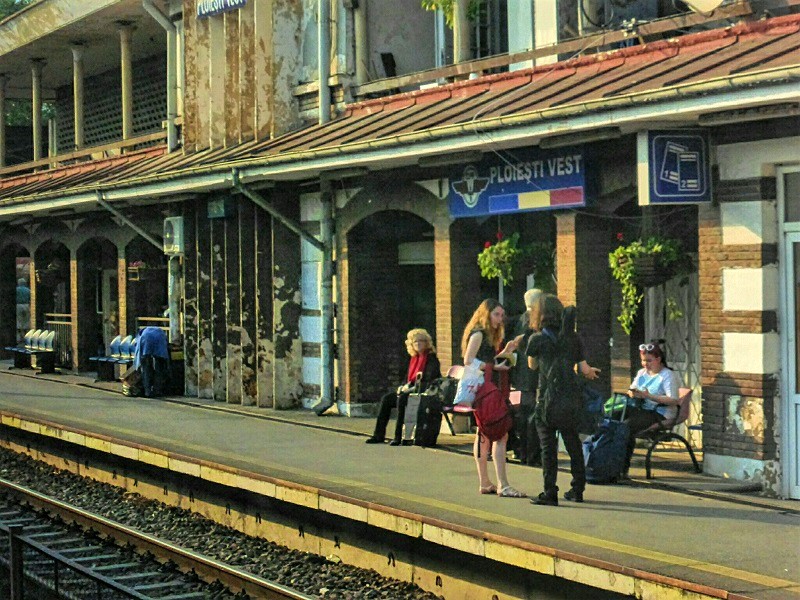
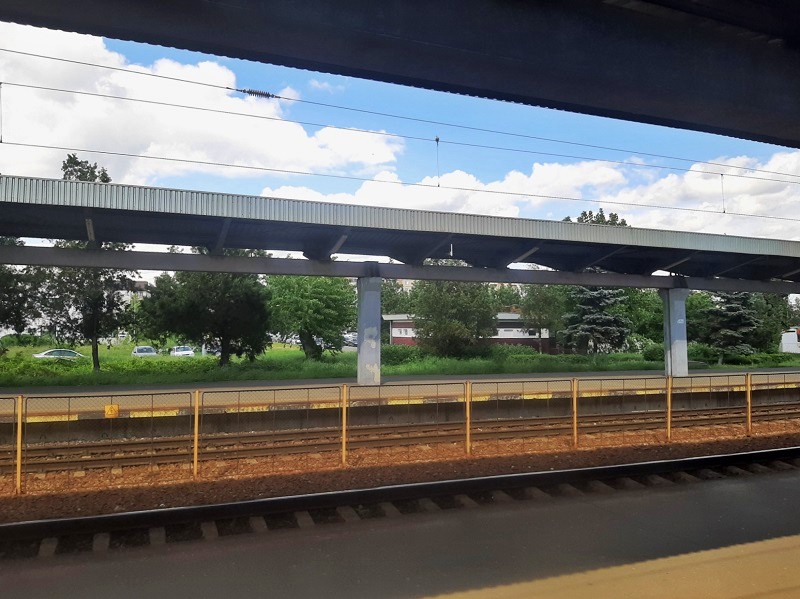
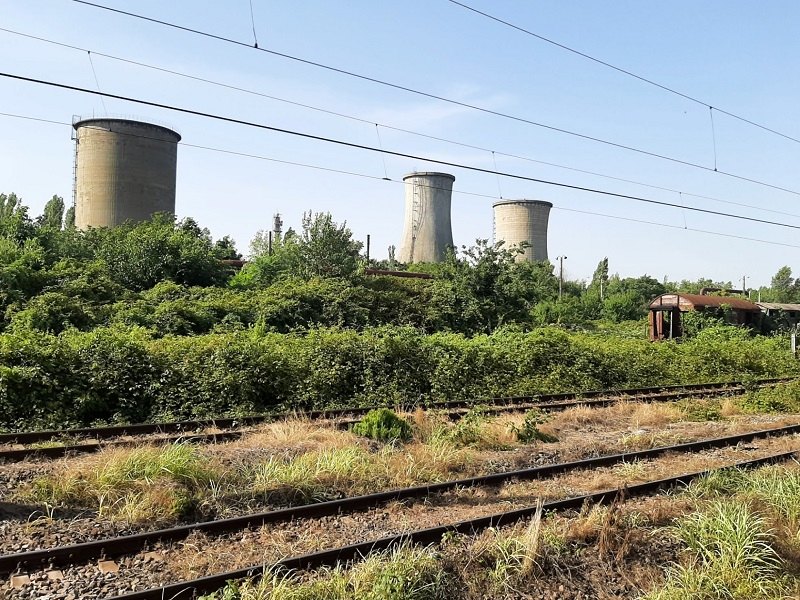
Bucharest arrival
The 40 minutes it takes the Dacia to cover the distance between Ploiești and Bucharest is rather boring as the Wallachian plain simply isn’t the most exciting bit of the journey.
After a while, the outskirts of Bucharest come into view and the train slows down as it approaches its final stop.
More than 19 hours after departing Vienna, the Dacia night train finally arrived at its final destination of București Gara de Nord (Bucharest North Station).
In the end, we arrived with a 50 minute delay as the train managed to take off 10 minutes from the initial one-hour delay by stopping shorter than initially scheduled at Brasov.


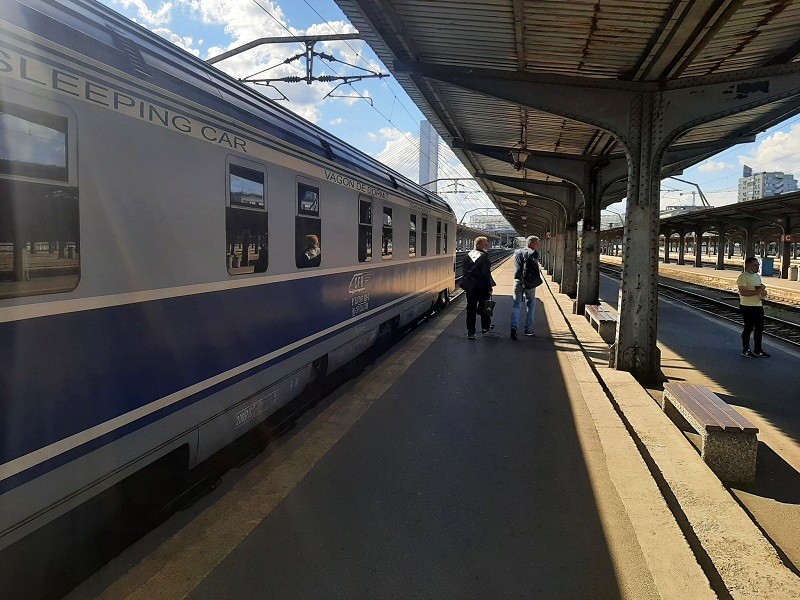


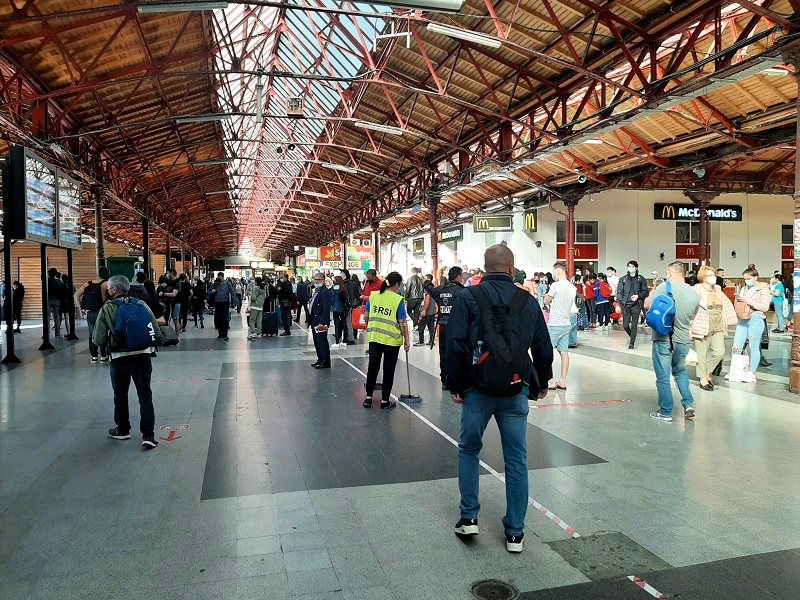
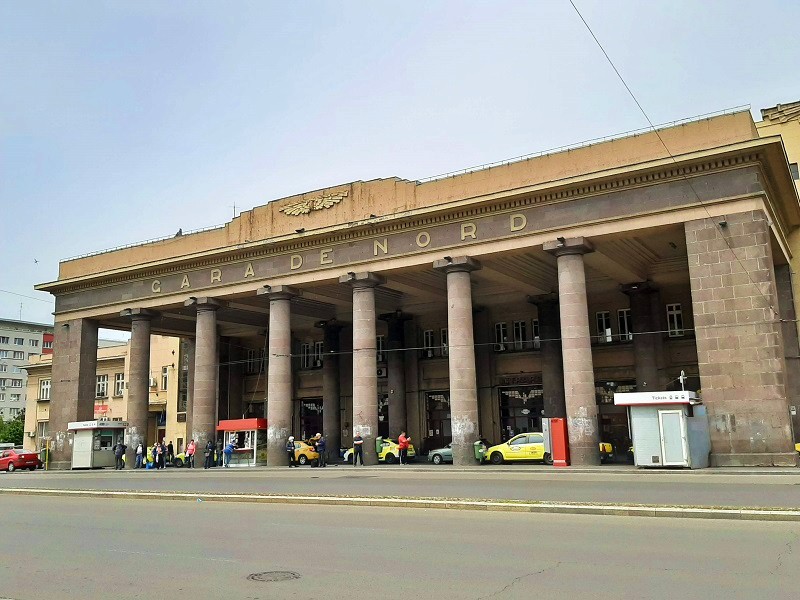

Conclusion
The Dacia night train between Vienna and Bucharest makes for an epic ride across a beautiful part of Europe.
At just over 19 hours in travel time, the Dacia night train is not the fastest way to travel between the Austrian capital of Vienna and the Romanian capital of Bucharest, although it surely is the most relaxed and enjoyable option.
The Dacia night train is affordable, comfortable and simply an experience in its own right.
Taking the Dacia night train is slow travel at its best and when you see the magnificent rural landscapes of Transylvania or the majestic Carpathian Mountains from your window you surely won’t regret hopping on board.
Especially when you travel in the comfort of your own private sleeper, the Dacia makes for one of Europe’s best train rides.
End of the trip
The journey on the Dacia night train between Vienna and Bucharest marked the end to my Interrail trip across Europe.
Although it was challenging to plan this trip due to the many travel restrictions at the time, it ended up being a relatively smooth trip.
Thanks for reading along with my entire journey. In case you might have missed some of the earlier chapters of this trip report, you can find the index below.
Feel free to leave a comment, or subscribe to our Facebook, Instagram or Twitter pages to receive instant updates when a new article is posted online! A simple like, follow or comment really makes our day and does help supporting this website.
Trip report index
This article is part of the ‘Across Europe by Train: Interrail in the Age of Corona‘ trip report, which consists of the following chapters:
1. Review: LOT Polish Airlines Economy Class Bucharest to Warsaw (Embraer ERJ-175)
2. Walking Through an Empty Warsaw in Corona Lockdown
3. Review: Four Points by Sheraton Warsaw Mokotow
4. Review: LOT Polish Airlines Economy Class Warsaw to Zurich (Boeing 737 MAX)
5. A Stopover Walk Through the Old Town of Zurich
6. Review: Railjet Train Zurich to Feldkirch
7. An Evening in Friendly Little Feldkirch
8. Review: Nightjet Train Feldkirch to Graz
9. A Short Walk Along the Sights of Graz
10. Review: Emona EuroCity Train Vienna – Ljubljana – Trieste
11. Zidani Most: Europe’s Most Picturesque Train Station
12. Review: Ljubljana to Zagreb by EuroCity Train EC 1211 ‘Sava’
13. Flying With Trade Air on a Let L-410 Turbolet Across Croatia
14. Review: Palace Derossi, Trogir, Croatia
15. A Visit to the Tranquil Island City of Trogir, Croatia
16. Cycling on Ciovo: A Trogir Day Trip by Bike
17. Split: Croatia’s Bustling Seaside City Full of History
18. Review: Croatian Railways ICN Train Split to Zagreb
19. Review: Esplanade Hotel, Zagreb, Croatia
20. Zagreb: A Guide to Croatia’s Underrated Capital City
21. Review: EuroCity Train “Croatia” Zagreb to Vienna
22. Review: Dacia Night Train Vienna to Bucharest (current chapter)

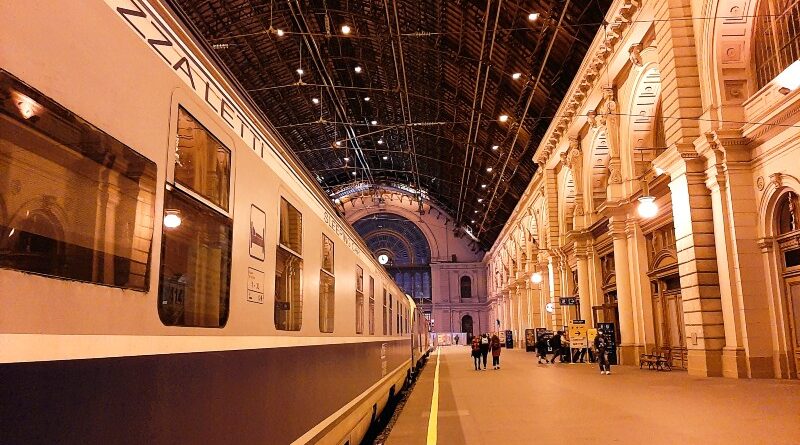
Wow what a great review! Thanks for all the details!
Great Review! Thank you Koen!
It looks like you took both the Dacia and the Ister, would you recommend one over the other?
The timing of the Ister seems better, but The comfort (plus possibility of an ensuite) make the Dacia seem nicer. Neither have dining cars anymore, right? Do both have showers, or is that just the Dacia.
Looking to travel in October Bucharest to Budapest.
Thanks again for your detailed review!
P.S: Have you done the overnight train from Bucharest to Chisinau?
I’ve done the Ister too multiple times – you can find the review at the link below in case you haven’t read it yet:
https://paliparan.com/2022/12/13/bucharest-chisinau-night-train-prietenia/
Usually, there are no compartments with en-suites on the Ister. However, on the last 2 occasions I took the train I was lucky to get a compartment with toilet/shower! So on that train it’s a coin toss.. also, note that if they use a sleeping wagon with en-suite compartments, just like the Dacia only half of the compartments with half them, the other ones just a washbasin only. To complicate matters, the compartment numbers which were en-suites the last time I took the Ister differed from those on the Dacia (eg. last time on the Ister I had berth 22, which turned out to be an en-suite – on the Dacia this normally isn’t an en-suite!). Bottom line is that with with CFR it’s always a lottery what the exact kind of rolling stock is!
For scenery I have a slight preference for the Dacia as the views are more diverse and you’ll see more of Romania in daylight hours. There are currently no dining cars on either train, sadly, although the Dacia *might* have a bistro counter in one of the 2nd class seat wagons selling drinks/snacks. However, it’s a 50/50% shot whether it’s staffed and open in the first place! Don’t rely on it and always bring your own food/drinks.
I’ve also done the Bucharest-Chisinau “Prietenia” night train multiple times. You can find a review of that train below:
https://paliparan.com/2022/12/13/bucharest-chisinau-night-train-prietenia/
Thanks Koen! I’ll check out your review on the Prietenia train.
Have you had any luck ordering tickets in advance to get the en suit? Based on what I read, to guarantee an en suit, you need to book at the station and in that case, only if they are available.
We are trying to book in advance online so that we are guaranteed a 2 person birth.
If timing wasn’t an issue, would you say the Dacia is the preferred one?
Thanks again!
That’s correct. Remember that there is a reason why you can’t get a 100% assurance for an en-suite: The frequent change in rolling stock. There are tricks to increase your chances of getting one of the en-suite compartments, but there is no such thing of a guarantee. If there was, then the Romanian Railways would have it as a separate (and more expensive) ticket category next to a standard sleeper. This way, you always get delivered what you actually bought (a trip in a sleeper compartment to Romania) and if you get an en-suite, well then you’re basically lucky to have this as a free extra.. I’d strongly suggest just to buy in advance online (unless you can buy at a station a couple a month or so in advance, but doing that 1-2 days in advance and you’ll risk the train being fully booked).
Booked the Dacia. Thanks again for all your help!
Does this journey count as one or two travel days on the interrail pass?
It counts as one day only (the day of departure). However, keep in mind that the arrival of the night train needs to fall within the validity of your pass – but it will no be counted as a travel day.
Hello, I’m traveling from Vienna to Brasov on The Dacia next month, using Interrail.
I’ve managed to reserve a seat for €3 with the OBB but would much prefer a couchette and am finding this impossible to do online.
Any suggestions?
Many thanks, Bill.
It’s easily possible through OBB!
1. Go to the OBB ticket shop:
https://shop.oebbtickets.at/en/ticket
2. Click on “adult without discounts”, as we will have to add the Interrail discount to your ticket query first. In the next window, we simply click “add discount”, followed by the option “Interrail / Eurail – Globalpass”. Click on this, click on OK, and it will be added to your profile.
3. If you now search for the Vienna-Brasov connection, it will list prices “from €3”. Click on this.
4. Now simply switch from the €3 seat reservation to a berth in a 6-pax couchette for €10.40, or a berth in a 4-pax couchette for €17.00! Or perhaps even go for a sleeper!